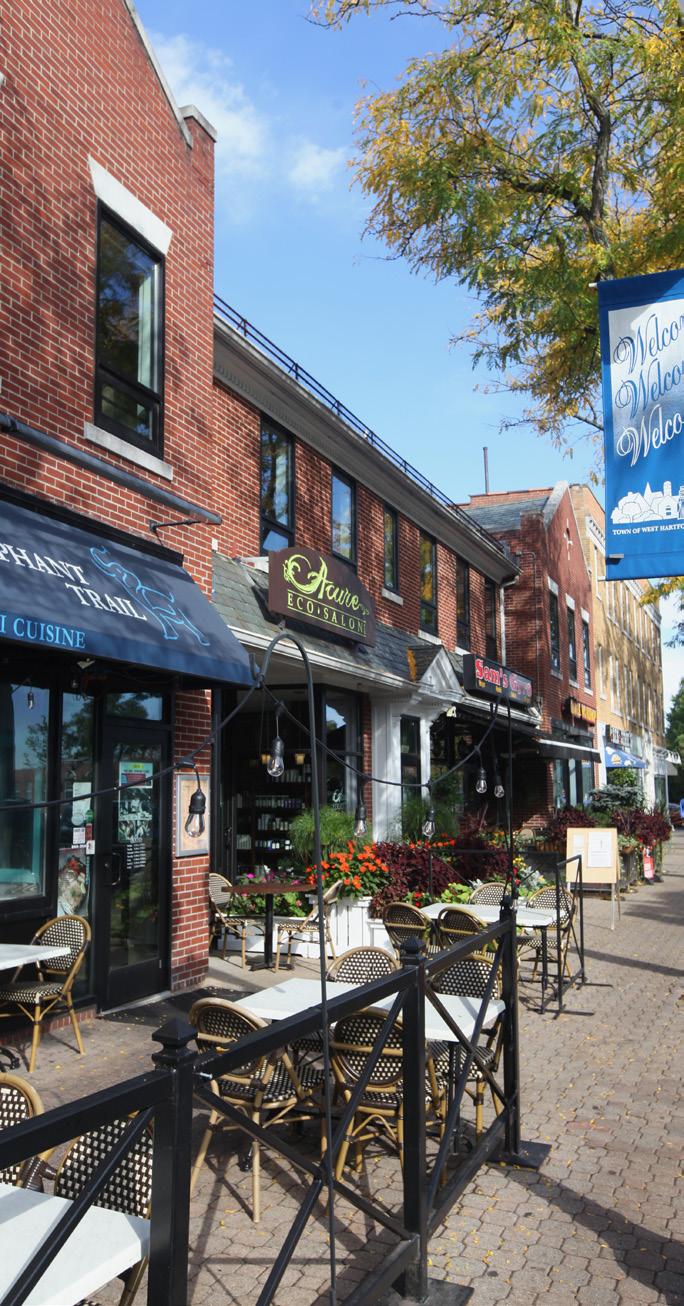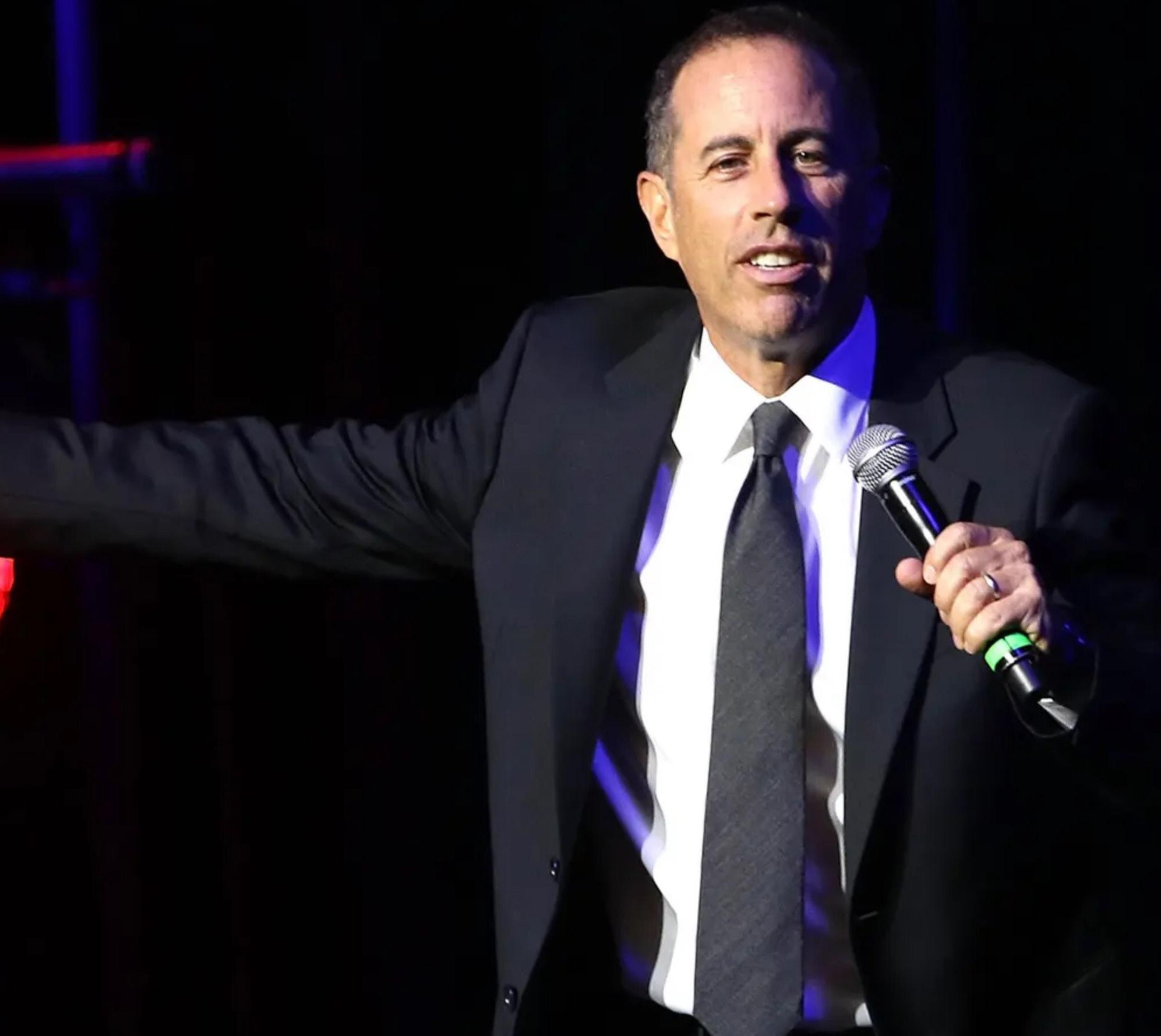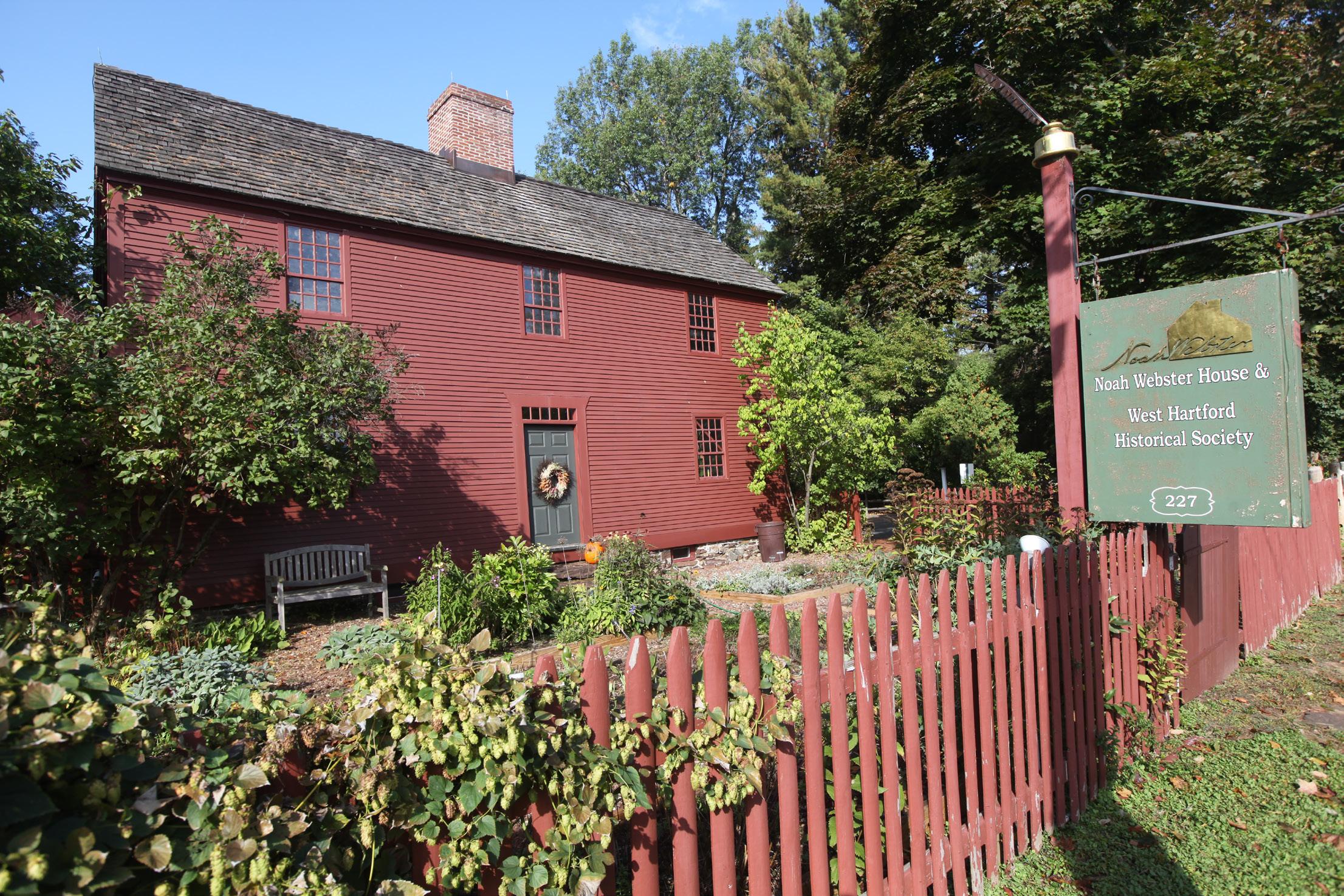
16 minute read
SPECIAL SECTION WEST HARTFORD – YESTERDAY, TODAY AND TOMORROW
WEST HARTFORD…YESTERDAY, TODAY & TOMORROW
It’s easy for those of us who live in West Hartford to take our extraordinary town for granted. The superb schools. The lush green parks and landscapes. The distinctive restaurants. The proximity to world-class museums and theaters. The endless awards and accolades.
In recent months, however, something interesting has begun to take root. You might even call it a phenomenon. Banished from their skyscraper offices and confined by COVID-19 to their pothole-sized apartments, pandemic-weary New York urbanites arerelocating to nearby suburban towns that offer great schools, excellent amenities, spacious homes and safe, more comfortable living.
HISTORY LESSON
A look back in time at the birth — and growth — of a Connecticut town
1672 — West Hartford is founded as a parish, consisting of “72 Long Lots” laid out between today’s Quaker Lane and Mountain Road. At the core of the community was the parish meeting house. The First Congregational Meeting House was built around 1712. Now in its 5th building, the church stands at what is now the southeast corner of Main Street and Farmington Avenue.
1775 — A slave named Bristow, who worked for Thomas Hart Hooker (and for whom a West Hartford middle school is today named), bought his freedom to fight in the Revolutionary War. Bristow continued to live with the family even after Thomas Hart Hooker was killed in the war. He became an agricultural expert and bequeathed his property to the Hookers’ two children when he died. He is the only known African American to be buried in West Hartford’s Old Center Burial Yard. Sarah Whitman Hooker House still stands on New Britain Avenue.
1792 — A committee of residents was appointed to ask permission from Hartford to secede, and were denied. Five years later they petitioned again, and again were denied.
1854 — A petition signed by 153 residents asking to establish their own town was delivered to the Connecticut General Assembly. On April 26, about 100 residents from West Hartford presented their own case against secession. After review and an opportunity for Hartford to make an argument for keeping West Hartford, the General Assembly voted on May 3 for West Hartford’s independence.
1854 — West Hartford is incorporated as a town.
1879 — Edwin Arnold established the Trout Brook Ice & Feed Company. Ice from Trout Brook, a stream that runs through the middle of West Hartford, was harvested in the winter, sawn into blocks, and placed into a series of ice houses through an escalator system. Insulated in sawdust, the blocks of ice were used as refrigeration locally and shipped as far away as New York City.
1891 — The Whitlock Coil Pipe Company opened, followed later by Royal Typewriter, Wiremold, Abbot Ball, Colt’s Manufacturing and Uncle Bill’s Silver Grippers (producer of tweezers). The largest of West Hartford manufacturers was Pratt & Whitney (now Pratt & Whitney Measurement Systems, which later lent its name to Pratt & Whitney, the aerospace corporation headquartered in East Hartford). In 1940 it built a plant and at the height of World War II it employed over 7,000 people. It would stand until 1991, when operations were relocated to Plainville.
1895 — Wealthy residents from the “East Side” of West Hartford petitioned Hartford for annexation. Their call was rebuffed by other West Hartford residents.That same year, Wood, Harmon and Company created one of the town’s first subdivisions on property known as Stanley Farm, a tract sloping upward from the trolley line that then ran along Farmington Avenue, across from Reservoir No. 1. Called Buena Vista, it was promoted it as “Hartford’s New and Handsome Suburb.”
1896 — Elizabeth Park was built. named for the wife of Charles M. Pond, who bequeathed the land to the City of Hartford, and designed by acclaimed landscape architect Frederick Law Olmsted.
1909 —The Connecticut Governor’s Residence was built on Prospect Avenue adjacent to Elizabeth Park.
1920s — The brainchild of Horace R. Grant, West Hill was located on the former estate of Cornelius Vanderbilt, son of the famous financier and transportation magnate. It was significant historically as an excellent example of a planned real estate development of the early 1920s. With architecture that characteristic of the Colonial Revival and Tudor Revival styles of the time, it was declared a National Historic District in 1996.
1910 to 1930 — The population of West Hartford grew from 4,808 to 24,941 residents.
1940 to 1960 — The population grew from 33,776 to 62,382.
1923 & 1924 — Hartford wanted to annex West Hartford back so that it could achieve a “Greater Hartford Plan.” Town residents rallied in opposition and the plan was defeated by a vote of 2,100 to 6,137.
1971 — The Bishops Corner development was inaugurated, housing tenants such as Lord & Taylor, F.W. Woolworth, and Doubleday Book Shop.
1974 — Towards the town’s southwest fringe lies Westfarms Mall. The mall’s original anchors included JC Penney, G. Fox & Co., and Sage-Allen. The mall recalibrated retail in West Hartford.
2007 — Blue Back Square opened adjacent, and as an addition, to the town’s popular downtown area known as West Hartford Center, as the community’s main hub. A pioneer mixed-use development adjacent to West Hartford Center blended retail and residential living space with a sidewalk vibe that gave it a unique vibrancy. The five-building complex includes a restaurants and shops, luxury apartments, professional and medical offices, two parking garages, a hotel, and more. Named after Noah Webster’s renowned spelling book, Blue-Back Speller, the development significantly altered the Center and furthered West Hartford’s burgeoning reputation as a regional dining and shopping destination.
West Hartford’s Favorite Sons & Daughters
CHIP ARNDT, gay rights activist, philanthropist, and co-winner of The Amazing Race 4
MICHELLE BEADLE, sports reporter and NBC Universal host
MANUTE BOL (1962–2010), NBA player
BEN BOVA, science fact and fiction author
TIM BRENNAN, guitar player and songwriter for Dropkick Murphys
CHRIS CARRABBA, singer–songwriter from Dashboard Confessional
DOMINICK DUNNE, (1925–2009) and JOHN GREGORY DUNNE (1932–2003), writers, were born in Hartford and grew up in West Hartford
JOHN L. FLANNERY, chairman & CEO, General Electric (GE)
JOHN FRANKLIN ENDERS, Nobel Laureate 1954 for Medicine
DORE GOLD, Ambassador to the United Nations from Israel MARTIN HAYES, Six Time All Ireland Fiddle Champion
GRAYSON HUGH, singer-songwriter, songs featured in Oscar-winning films “Thelma and Louise” and “Fried Green Tomatoes”
LIZ JANANGELO, professional golfer on the LPGA Tour
JARED JORDAN, drafted 45th by Los Angeles Clippers in the 2007 NBA Draft
CHARLIE KAUFMAN, Academy Award winning and screenwriter of “Being John Malkovich” and “Eternal Sunshine of the Spotless Mind”
EDWARD LORENZ, mathematician and meteorologist, early pioneer of chaos theory, inventor of the strange attractor notion, made the term “butterfly effect” popular
FRANK LUNTZ, Republican pollster
KENNY MAYNE, ESPN personality
JOSEPH MASCOLO, actor and soap opera veteran
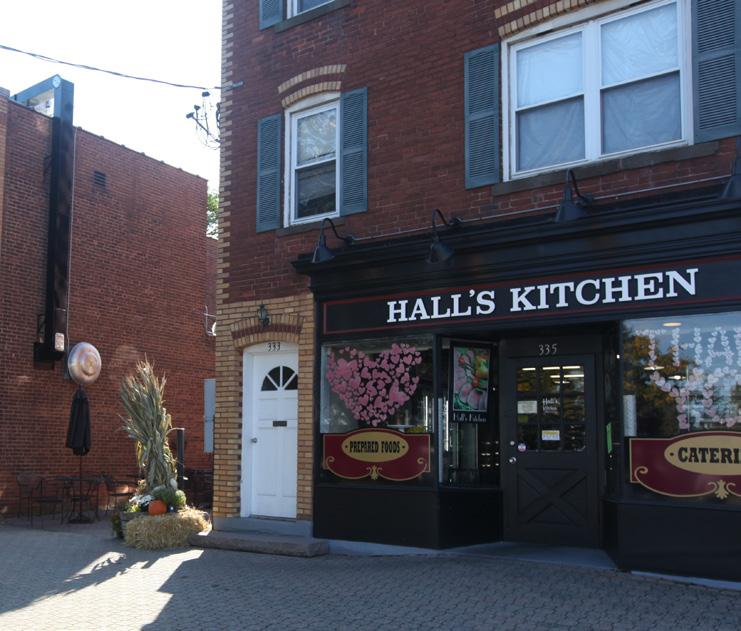
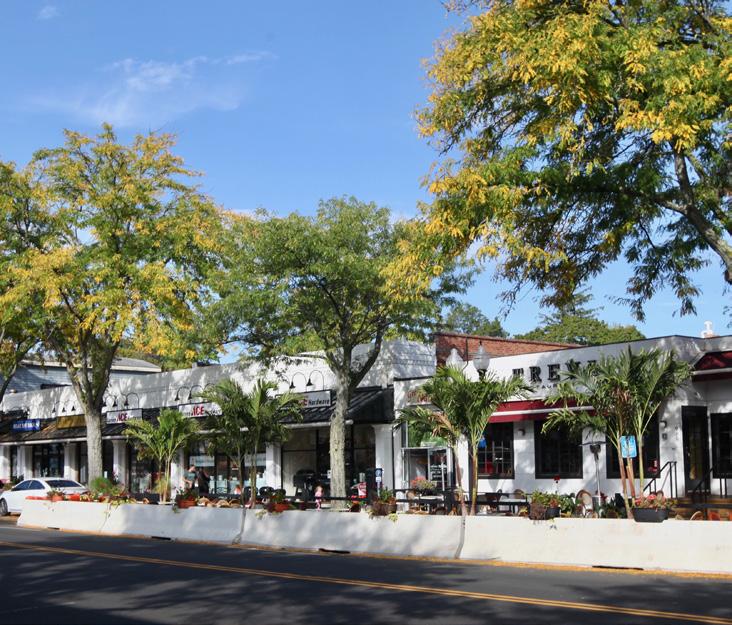

BRETT H. MCGURK, Special Adviser to the United States Ambassador to Iraq
JASON MUZZATTI, former NHL goalie, played with the Hartford Whalers
JOHN O’HURLEY, actor on Seinfeld television series and former Family Feud host
PETER PAIGE, actor
RYEN RUSSILLO, ESPN personality
MICHAEL SCHUR, creator of “Parks and Recreation” and “The Good Place”
WILLIAM THOMPSON SEDGWICK, professor at the Massachusetts Institute of Technology and a key figure in shaping U.S. public health
SCOTT VAN PELT, ESPN personality
ADNAN VIRK, sportscaster
NOAH WEBSTER, lexicographer, textbook author, Bible translator, spelling reformer, writer, and editor
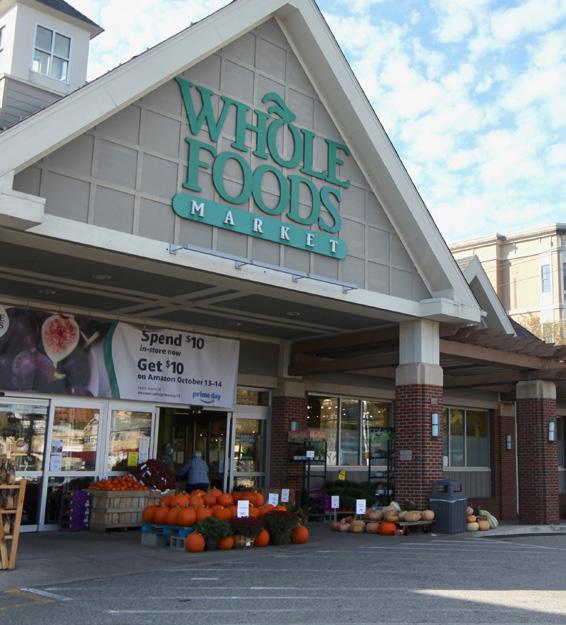
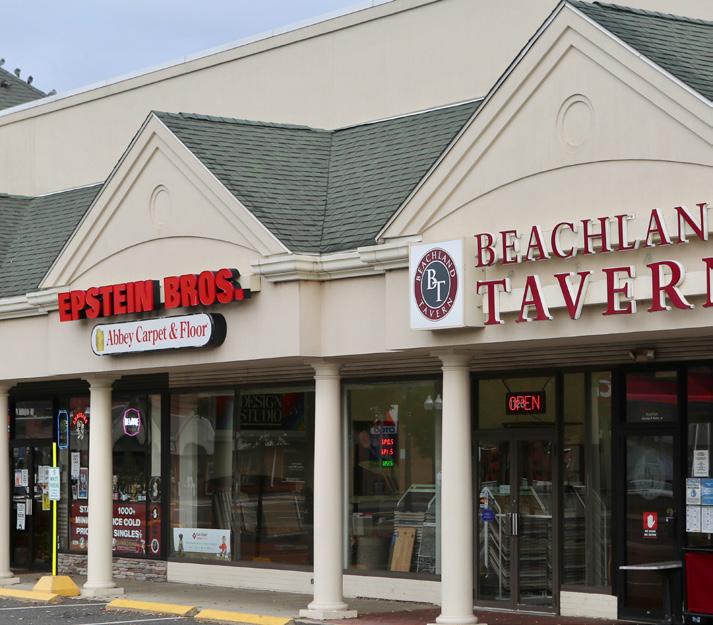



MOVING DAY
BY JUDIE JACOBSON
A top West Hartford real estate agent says, even in the time of COVID, it’s all about supply & demand
Residents of West Hart-
ford and its neighboring towns have no trouble remembering the name Robin Gebrian.
Why would they? As one of Connecticut’s top real estate agents, Gebrian’s name is a ubiquitous voice calling out to passers-by from the lawn signs of so many homes for sale (or sold) throughout town.
Gebrian, who has logged 30 years of real estates sales experience, was a winning agent almost from the day she signed on with Prudential Connecticut Realty’s Hartford office.
“That first year I was the top agent in the office,” Gebrian who is today a real estate professional with William Raveis, recalls.
How did that happen?
“I didn’t realize that people who knew me from my [private] life would refer people to me even though I didn’t have experience. I guess they trusted that I would know what I was doing!” she says with a laugh.
A native of South Bend, Indiana, Gebrian’s has familial roots in Norwalk, Connecticut and Springfield, Massachusetts. After graduating from Syracuse University, where she studied family relations and child development, she settled in western Connecticut. An adoption social worker with Child and Family Services, she left after 11 years to raise her two children.
Thirteen years after moving to Connecticut, Gebrian relocated to West Hartford.
“I bought my house when my daughter was ready for school because the schools in West Hartford are so good,” she explains.
Once both her daughter and son were in school, she was ready to return to work — but not as a social worker. Instead, she sought a job with the kind of flexibility that would allow her to be there for her kids. Real estate sales fit the bill.
Three weeks after signing on with Prudential, she sold her first house. Three weeks after that, she sold a house to that same client whose house she had just sold.
“I’ve loved the job from the beginning,” says Gebrian. “Sure, there are difficult times — but I love meeting new people and I love helping them with something that is so important to them.”
The secret of her success: “I try to do a great job for everybody who asks for my help. I try to figure out what my client wants and I try and find it.”
And so, when we set out to learn how the real estate market in West Hartford was faring during these challenging times, and what West Harfordites should watch for, we knew there was just one person to talk to: Robin Gebrian. Here’s what she had to say. Q: YOU WORK THROUGHOUT THE GREATER HARTFORD AREA. TELL US HOW THE WEST HARTFORD REAL ESTATE MARKET COMPARES WITH THE MARKETS IN NEIGHBORING TOWNS.
ROBIN GEBRIAN: The market fluctuates according to lots of different factors — such as the economy — and West Hartford really has always been the best market. In other words, when the market goes down, it goes down in West Hartford last; and when it comes up, it comes up in West Hartford first.
It all comes down to supply and demand. In West Hartford, no matter who you are, no matter what you look like, no matter how much money you have, no matter what your family lifestyle is, there is somebody like you. Think about it: There are 67 languages spoken in West Hartford — and that’s an old statistic, it’s higher now. There are so many different nationalities and so many different lifestyles.There are first time buyer houses and there are million dollar houses. We have it all. And, as result, West Hartford is going to get more eyes on it because of the town’s diversity — diversity of product and diversity of people — in addition to being a well-run, dynamic town with good schools, etc.
I’m not here to say West Hartford is the best town. I’m here to say that in terms of the real estate market, we have more appeal to more people and that means more demand. And, again, real estate is all about supply and demand.
So, it’s no wonder real estate agents in the surrounding towns watch West Hartford. If the market’s gone down
and they want to know what it’s going to come back up, they’ll just watch West Hartford. They know that if West Hartford begins to come up, their towns are going to come up.
HOW IS THE WEST HARTFORD REAL ESTATE MARKET FARING DURING THIS PANDEMIC?
Right now is unique, again because of supply and demand. Many people who were going to put their house on the market this past spring didn’t, or they delayed putting it on. And the same goes for buyers who may have wanted to buy but didn’t. As an example, before the pandemic started, I had two people ready to go. One was downsizing and another wanted to upsize. They both put their searches on hold for about two months, and then they both said, “If we can find a house and go forward.” By then we had figured out how to do that safely.
So really what happened was, there were not enough houses coming on the market because of COVID, but there were a lot of buyers who really wanted to buy for various reasons, and people who were at home and had the time to look at what was on the market. It was the perfect storm for a very good real estate market.
And we’re still in it. We still don’t have enough houses. At any given time it is very hard to find what you want, when you want it, for the price you want it. It doesn’t matter what kind of market it is.
IN TODAY’S ENVIRONMENT, HOW DO YOU MANAGE TO SHOW PEOPLE HOMES SAFELY?
We worked online in the early stages [of the pandemic]. If a couple had a house they were interested in, I would ask the agent who had the listing to go to the house and use their cell phone to give the client and myself a tour of the house while we watched on Zoom. That way we could ask questions and revisit particular rooms or areas we wanted to see. It was a safe way in the beginning for us to see houses. Sometimes, if the agent couldn’t make it, I would go to the house myself and do the tour for the client.
Later on, people realized that if we made it safe for buyers and sellers — if we all wore masks and gloves, and if we sanitized and limited the number of people walking through the house — we could show houses, because generally it’s just you and your buyers and often the houses are already vacant.
IT’S BEEN REPORTED THAT MANY NEW YORK CITY RESIDENTS INTERESTED IN RELOCATING TO SUBURBAN TOWNS ARE EXPLORING WEST HARTFORD. TRUE…OR WISHFUL THINKING?
West Hartford has definitely been a key town for people moving out of New York City. One weekend not that long ago I must have gotten five calls from New York City people interested in looking at West Hartford. One of the houses I sold in West Hartford recently was to a couple who came up here with their new baby to stay with one of their parents [during the pandemic.] Once they got here they decided they wanted to stay here and not go back.
I think it’s primarily because they’re used to a cosmopolitan area. They’re used to walking everywhere; to having sidewalks and restaurants, and being close to everything. Can you think of another [suburban] town that comes close to that — a place where you can have more land, etc.?
IS THERE A LIFECYCLE TO THESE KIND OF MARKETS? CAN YOU PREDICT WHEN IT MIGHT BE OVER?
No, because real estate is affected by many factors. It’s a commodity just like stock. For sure it’s a great time to sell. The interest rate is lower than it’s ever been — it’s under three percent, and that’s another reason there are so many buyers. Even before this pandemic hit there were lower interest rates and that does make a difference. If money is cheap and you can improve yourself and you have a good job, why not?
ANY PARTICULAR PIECE OF ADVICE FOR BUYERS…
A lot of people don’t think about resale and they should always take resale into consideration. I always point out to people interested in a particular house that these are the challenges for resale in this particular place and when you go to sell this is what you will need to understand that.
…AND FOR SELLERS?
It’s always about price. That’s the number one thing one learns after all these years. It’s always a price issue. People will ask, “Why isn’t my house selling?” And even if I haven’t seen the house I know it’s the price — that something about the house doesn’t match the price. And there’s no empirical data that you can put together to arrive at the right price; you have to have an agent who understands the value in your particular market for your particular house to arrive at the right price.
West Hartford by the Numbers
The following demographic data is based on projections of the latest U.S. Census estimates, as well as data accumulated by various sources for the years 2014 — 2018.

22.3 — The square mileage of West Hartford, of which 21.9 square miles is land and 0.42 square miles (or 1.91%), is water.
3,565,287 — Population of Connecticut.
63,127 — Population of West Hartford (as recorded in 2020).
24,491 — Households in West Hartford.
48,865 — Adults living in West Hartford.
41.1 — Median age of West Hartford residents (median age in CT: 40.6; median age nationally: 37.7).
11,311 — Senior adults living in West Hartford.
74 — Number of different languages spoken by West Hartford residents. 91.6 — Percentage of West Hartford households with a computer.
94.5 — Percentage of West Hartford residents who are high school graduates or higher (in Connecticut: 90.5%).
63.6 — Percentage of residents holding a bachelor’s degree or higher (in Connecticut: 38.9%).
58 — Percent of West Hartford residents who are married.
47 — Percent of West Hartford families with children under 18.
292,000 — Median dollar value of homes in West Hartford.
2,356 — West Hartford residents who are U.S. military veterans (between 2014-18).


by the Numbers
83.35 — Percentage of West Hartford residents who were born in the United States (50.38% were born in Connecticut).
8 — Car break-ins in 2019 (all were unlocked).
98 — percentage of students in West Hartford’s two high schools who graduate.
457 — National ranking of Hall High School by US News & World Report in 2020. The ranking indicates how high schools perform nationally out of 17,792 nationally ranked schools. 8 — Statewide ranking of Hall High School by US News & World Report in 2020. Ranking indicates how high schools perform statewide out of 216 schools in Connecticut.
642 — National ranking of Conard High School by US News & World Report in 2020. The ranking indicates how high schools perform nationally out of 17,792 nationally ranked schools.
13 — Statewide ranking of Conard High School by US News World Report in 2020. Ranking indicates how high schools perform statewide out of 216 schools ranked in Connecticut.
